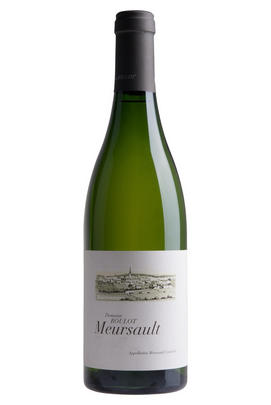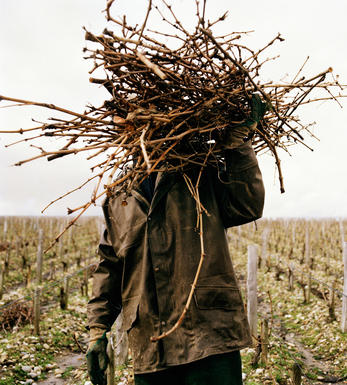
2011 Meursault, Clos des Bouchères, 1er Cru, Domaine Roulot, Burgundy

Critics reviews
Just as he was about the 2010 vintage, Jean-Marc Roulot was notably enthusiastic about the 2011 vintage as well, declaring firmly that he "loves the vintage despite the fact that the growing season was very challenging. The growing season began very early just as it did in 2003 and 2007 and as a consequence the harvest was exceptionally early as well. Near perfect weather during April, May and June, though July was terrible as was the first half of August. Remarkably enough we began picking on the 24th of August for a few parcels and then started seriously on the 27th. There was basically zero sorting required as the chardonnay was spotless. Yields were better than in 2010 at between 40 to 45 hl/ha. Jean-Marc Roul believes that they will age better than most people think because they are so well-balanced.
Allen Meadows - burghound.com - July 2013
About this WINE

Domaine Guy Roulot
Jean-Marc Roulot has been in charge since 1989, when he decided to stay with the vines rather than to pursue a full time career as an actor on stage and film, subsequently bringing a fine domaine up into the very top league. He is one of the few producers who has managed to move from heavier to purer wines without losing anything of the wine’s potential quality and complexity. Everything is still in place, both the greater pull of fabulous white Burgundy and the more detailed intricacies of the subtle differences between one terroir and another.
The wines are built, not in the sense of any artificial construction, but by the weaving of layers one upon another. These are exceptional Meursaults which show their real class at 10 years old. The vineyards have been farmed organically since 1999, with some experiments in biodynamics - all is in place for first class raw material and Jean-Marc is not afraid to pick early if the condition of the grapes suggests it. Where the skins of the grapes are healthy, Jean-Marc likes to crush them before pressing, which he finds gives a greener juice with a degree more acidity but without changing the pH of the wine. The barrels fulfil their role of aerating the wine, with no more than 20% new wood for village wines and 25-30% for the crus.
Jasper Morris MW, Burgundy Wine Director and author of the award-winning Inside Burgundy comprehensive handbook.

Meursault
There are more top producers in Meursault than in any other commune of the Côte d’Or. Certainly it is the most famous and popular of the great white appellations. Its wines are typically rich and savoury with nutty, honeyed hints and buttery, vanilla spice from the oak.
Even though it is considerably larger than its southerly neighbours Chassagne and Puligny, Meursault contains no Grands Crus. Its three best Premiers Crus, however – Les Perrières, Les Genevrières and Les Charmes – produce some of the region’s greatest whites: they are full, round and powerful, and age very well. Les Perrières in particular can produce wines of Grand Cru quality, a fact that is often reflected in its price. Meursault has also been one of the driving forces of biodynamic viticulture in the region, as pioneered by Lafon and Leflaive.Many of the vineyards below Premier Cru, known as ‘village’ wines, are also well worth looking at. The growers vinify their different vineyard holdings separately, which rarely happens in Puligny or Chassagne. Such wines can be labelled with the ‘lieu-dit’ vineyard alongside (although in smaller type to) the Meursault name.
Premier Cru Meursault should be enjoyed from five to 15 years of age, although top examples can last even longer. Village wines, meanwhile, are normally at their best from three to 10 years.
Very occasionally, red Meursault is produced with some fine, firm results. The best red Pinot Noir terroir, Les Santenots, is afforded the courtesy title of Volnay Santenots, even though it is actually in Meursault.
- 305 hectares of village Meursault. The best vineyards include Clos de la Barre, Tesson, Chevalières, Rougeot, Narvaux
- 132 hectares of Premier Cru vineyards (17 in all). The finest vineyards include Les Perrières, Les Genevrières and Les Charmes
- Recommended producers: Comte Lafon, Arnaud Ente, Coche Dury, Guy Roulot, Jean-Philippe Fichet, Patrick Javillier, François Jobard, Michel Bouzereau
- Recommended restaurant: Le Chevreuil

Chardonnay
Chardonnay is often seen as the king of white wine grapes and one of the most widely planted in the world It is suited to a wide variety of soils, though it excels in soils with a high limestone content as found in Champagne, Chablis, and the Côte D`Or.
Burgundy is Chardonnay's spiritual home and the best White Burgundies are dry, rich, honeyed wines with marvellous poise, elegance and balance. They are unquestionably the finest dry white wines in the world. Chardonnay plays a crucial role in the Champagne blend, providing structure and finesse, and is the sole grape in Blanc de Blancs.
It is quantitatively important in California and Australia, is widely planted in Chile and South Africa, and is the second most widely planted grape in New Zealand. In warm climates Chardonnay has a tendency to develop very high sugar levels during the final stages of ripening and this can occur at the expense of acidity. Late picking is a common problem and can result in blowsy and flabby wines that lack structure and definition.
Recently in the New World, we have seen a move towards more elegant, better- balanced and less oak-driven Chardonnays, and this is to be welcomed.


Buying options
Add to wishlist
Description
This is notably elegant and aromatically fine with its pure essence of pear, dried flowers and citrus peel influences. There is a lovely sense of underlying tension to the very finely detailed flavors that exude a discreet minerality onto the dry, clean and almost delicate finish. This lovely and understated effort is not at all dramatic but it charms and seduces with its impeccable sense of harmony and balance. I really like this.
Just as he was about the 2010 vintage, Jean-Marc Roulot was notably enthusiastic about the 2011 vintage as well, declaring firmly that he "loves the vintage despite the fact that the growing season was very challenging. The growing season began very early just as it did in 2003 and 2007 and as a consequence the harvest was exceptionally early as well. Near perfect weather during April, May and June, though July was terrible as was the first half of August. Remarkably enough we began picking on the 24th of August for a few parcels and then started seriously on the 27th. There was basically zero sorting required as the chardonnay was spotless. Yields were better than in 2010 at between 40 to 45 hl/ha. Jean-Marc Roul believes that they will age better than most people think because they are so well-balanced.
Allen Meadows - burghound.com - July 2013
wine at a glance
Delivery and quality guarantee